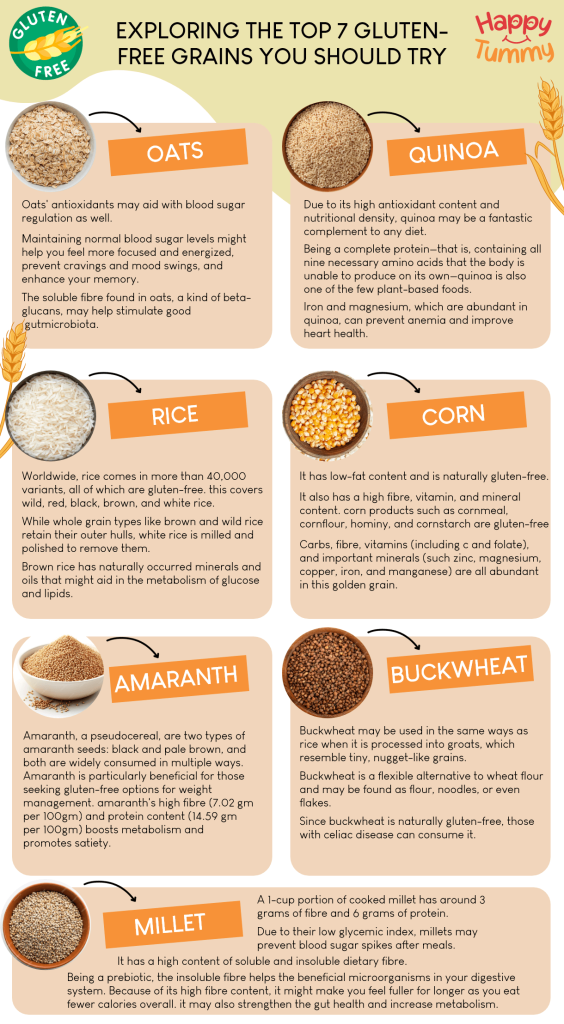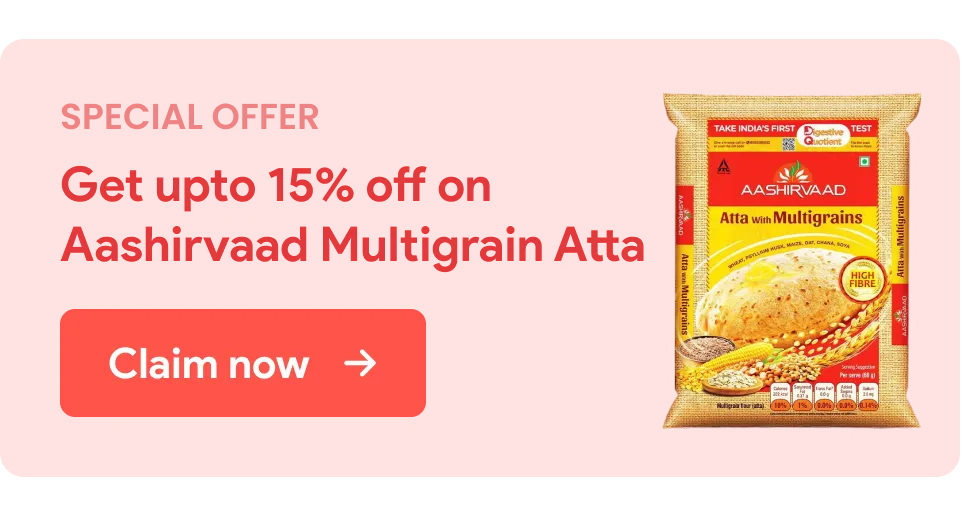Table of Contents
Grains are an essential component of every diet. Without grains, it would be hard to envision a meal, especially in our Indian culture and lifestyle. For those following a gluten-free diet many of us may think that following a gluten-free diet might be difficult. This is untrue.
Botanically speaking, buckwheat (Kuttu), quinoa, and amaranth (Chaulai, Rajgira, Ramdana)—are gluten-free “pseudocereals,” while being referred to as “grains” in popular culture. As a result of their comparable uses and largely comparable nutritional characteristics, they have earned the designation of grains.
This article will provide you with a list of gluten-free grains that you can consume whole or ground into flour frequently by combining several gluten-free flours.
Gluten-Free Grains
The “yes list” of gluten-free grains is extensive and diverse, offering over a dozen options and a variety of delectable ways to include them in your regular diet. Among these grains are:

1. Oats
Oats are whole grains that are free of gluten and rich in antioxidants, fibre, vitamins, and minerals. They provide several health advantages [1]. Oats’ antioxidants may aid with regulating blood sugar, helping you feel more focused and energized, preventing cravings and mood swings, and enhancing your memory.
The soluble fibre found in oats, a kind of beta-glucans, may help stimulate good gutmicrobiota [2].
Furthermore, the high fibre content of oats may help you feel full and satiated for a long time, thereby aiding in weight management. Additionally, oats have few calories. The fibre in oats may aid with bowel motions and digestion [3]. So, consuming oats during your gluten-free diet can prove beneficial because of its various nutrient contents.
Depending on the processing method, oats come in a variety of shapes. There are various varieties such as steel-cut, rolled or old-fashioned, fast or instant, oat groats, and oat bran. Even oat flour is available for use in baked products.
- Pro Tip: Enjoy the warm bowl of oats garnished with honey and fruit for breakfast, or use them in granola or muesli preparations. Alternatively, prepare flavourful oats combining cheese and paneer, and then serve them like porridge. Additionally, oats taste great when included in cookie and bread dough.
2. Quinoa
Quinoa, technically a kind of seed, is a grain-like, gluten-free pseudo-grain available in a variety of hues, including black, red, white, and yellow. Due to its high antioxidant content and nutritional density, it may be a fantastic complement to any diet [4].
Being a complete protein—that is, containing all nine necessary amino acids that the body is unable to produce on its own—quinoa is also one of the few plant-based foods [5]. This small grain is a wonderful source of fibre; therefore, adding it would be the ideal choice if you want to keep your digestive system healthy.
Iron and magnesium are abundant in quinoa, which can prevent anemia and improve heart health. Because of its high manganese content, it may aid with regulating blood sugar. It is a fantastic choice for those with diabetes because it also has a medium glycemic index [6].
- Way to Use: Quinoa has a light, fluffy texture and nutty flavor. It may be added to salads, consumed as morning porridge, or used as a side dish in place of rice. It can also be used to thicken soups and stews. However, you should wash the grain properly before cooking to avoid the side-effects of chemicals being used as pesticides while growing it.
Do you want your dosas and rotis to be healthy? The five potent millets used to make our Multi Millet Flour are Quinoa, Bajra, Ragi, Jowar, and Navane. Incorporating millet into your regular diet will improve your health over time.
3. Rice
A common ingredient in cuisines all around the world is rice, a starchy grain. Worldwide, rice comes in more than 40,000 variants, all of which are gluten-free. This covers wild, red, black, brown, and white rice.
While whole grain types like brown and wild rice retain their outer hulls, white rice is milled and polished to remove them. Due to its high fibre content and plenty of other nutrients, whole-grain rice is a more nutrient-dense choice [8].
In addition, brown rice has naturally occurring minerals and oils that might aid in the metabolism of glucose and lipids, raising HDL (good) cholesterol and lowering LDL (bad) cholesterol [9]. Because of its high fibre content, it might make you feel fuller for longer as you eat fewer calories overall. It may also strengthen gut health and increase metabolism [10].
Rice can be light and fluffy, chewy and nutty, or sticky, depending on the length, breadth, and starch content of each grain. Try out different kinds to see which one you like most. Rice is a staple food and in your journey to a gluten-free diet, you can consume it without guilt.
It tastes well with curries or vegetables, as well as in kheer and soups. Gluten-free baking mixes frequently contain rice flour.
#4 Corn
Whole grains like corn can add nutritional value to your diet. It has low-fat content and is naturally gluten-free. It is high in fibre, vitamins, and minerals. Corn products such as cornmeal, cornflour, hominy, and cornstarch are gluten-free[11].
Carbs, fibre, vitamins (including C and folate), and important minerals (such zinc, magnesium, copper, iron, and manganese) are all abundant in this golden grain [12]. Because it is mostly made up of insoluble fibre, it digests slowly.
Additionally, it can function as a prebiotic to promote the development of beneficial gut bacteria.
Tip 1: Try making salads or soups with corn kernels, and create gluten-free cornbread or roti with cornmeal. Corn tortillas are great for sandwiches.
#5 Millet
The popularity of millet has just lately increased. For hundreds of years, people have farmed this naturally gluten-free grain throughout Africa and India.
A 1-cup portion of cooked millet has around 3 grams of fibre and 6 grams of protein, demonstrating the nutritional density of millet [13]. Due to their low glycemic index, millets may prevent blood sugar spikes after meals. It has a high content of soluble and insoluble dietary fibre.
Being a prebiotic, the insoluble fibre helps the growth of beneficial microorganisms in your digestive system [14]. Moreover, the fibre can give your stool more volume, and regularize your bowel movements. Soluble fibre, which may reduce blood cholesterol, is also abundant in these grains [15].
Magnesium is also abundant in millet and may improve heart functioning and overall heart health. Rich in phytates, phenols, and tannins, millet may help shield your cells against dangerous illnesses, including diabetes, high blood pressure, and high cholesterol.
- Best Practice: Always soak it overnight before cooking to minimize the amount of anti-nutrients. To bring out the nutty taste, you might roast it in a pan before cooking. Incorporate this gem into your diet daily and see how it improves your overall health.
Here are some common Millet for you:
- Pearl millet: Bajra
- Finger millet: Ragi
- Foxtail millet: Kangni
- Barnyard millet: Samwa
- Little millet: Kutki
- Kodo millet: Kodra
- Proso millet: Cheena
- Browntop millet: Andua
- Japanese millet: Japani Bajra
- Sorghum: Jowar
With its unique combination of millets, Aashirvaad Multi Millet Mix provides your family with the many health advantages of a nutritious grain blend. You get the health advantages and enjoy a distinct flavour in your dishes!
#6 Buckwheat (Kuttu)
Though its name includes the word “wheat,” buckwheat is essentially a seed and is occasionally called a “pseudo-grain.” Buckwheat may be used in the same ways as rice when it is processed into groats, which resemble tiny, nugget-like grains.
Since buckwheat is naturally gluten-free, those with celiac disease can consume it without hesitation as it is not related to wheat. In addition to providing fibre, itt has a low to medium glycemic index. This indicates that its impact on blood sugar levels is mild [16].
It’s full of heart-healthy minerals, like fibre and magnesium. It is also a good source of quercetin and rutin, two plant components with antioxidant and protective qualities.
Buckwheat is high in fibre, particularly resistant starch and insoluble fibre, both of which are particularly beneficial to gut health. This is because the gut’s helpful bacteria use these fibres as fuel, which encourages them to proliferate and concurrently create by-products favourable to gut health.
#7 Amaranth
Amaranth, a pseudocereal, are two types of amaranth seeds: black and pale brown, and both are widely consumed in multiple ways.
Amaranth is particularly beneficial for those seeking gluten-free options for weight management. Amaranth’s high fibre (7.02 gm per 100gm) and protein content (14.59 gm per 100gm) boosts metabolism and promotes satiety. Thus, it aids in feeling fuller for extended hours, reducing the likelihood of snacking between meals and promoting weight loss. [7]
Ways to Use Amaranth: With amaranth, you can make rajgira kheer, curry, tikkis, parathas, energy bars, laddoos, and much more. It can also be used as an alternative to cornstarch as a thickening agent for soups, sauces, or curries.
Also, you can grind it into flour for gluten-free baking, making it a versatile ingredient in your kitchen.
Word of Caution
During the milling and packing process, gluten-free grains might nonetheless come into touch with gluten-containing materials. It is preferable to seek packaging with a gluten-free label if you want to be sure you are not exposed to gluten.
Gluten-free grains that are cultivated, processed, or manufactured close to gluten-containing enhance the possibility of becoming contaminated during the production process.
It’s crucial to select items that are third-party tested certified gluten-free and made in gluten-free facilities if you have a severe sensitivity.
Gluten: Checking the Label
Understanding ingredient labels is crucial for anybody with celiac disease or gluten-intolerance to stay away from gluten-containing foods, drinks, and medications.
Because the FDA only permits packaged goods with less than 20 parts per million (ppm) of gluten to bear the label, products that make such claims are probably safe to consume [17]. You should still review the components list, though. It’s also critical to keep in mind that “gluten-free” does not equate to “wheat-free.”
Look for evident elements like:
- Yeast for brewing
- Wheat
- Barley
- Rye
- Malt
Examine the ingredients label carefully if the product package does not include a “gluten-free” designation. Look for substances that are unclear or concealed. There’s a chance that certain items contain gluten. If you have any doubts, it is preferable to seek expert/dieticians’ advice.
The Bottom Line
These healthy gluten-free grains can improve your health in several ways by supplying you with essential nutrients.
There is no need to give up grains when following a gluten-free diet. To be sure a product is certified gluten-free, always read and understand the labels.
Frequently Asked Questions
Gluten-free grains are widely available. When these grains are being grown, milled, or manufactured, they may come into touch with other goods or grains that contain gluten. That’s why it’s crucial to purchase gluten-free products, preferably those that have received the necessary certification.
No, those who have gluten sensitivity or celiac disease can safely eat a variety of gluten-free grains. These comprise, among other things, amaranth, millet, and quinoa.
A gluten-free diet consists of avoiding foods that contain wheat, rye, and barley protein or gluten. You cannot consume these foods if you have gluten sensitivity or celiac disease. Certain grain products are safe for people with certain diseases to consume, and not all grains contain gluten. On the other hand, all grains are prohibited from a grain-free diet, regardless of their gluten content.















